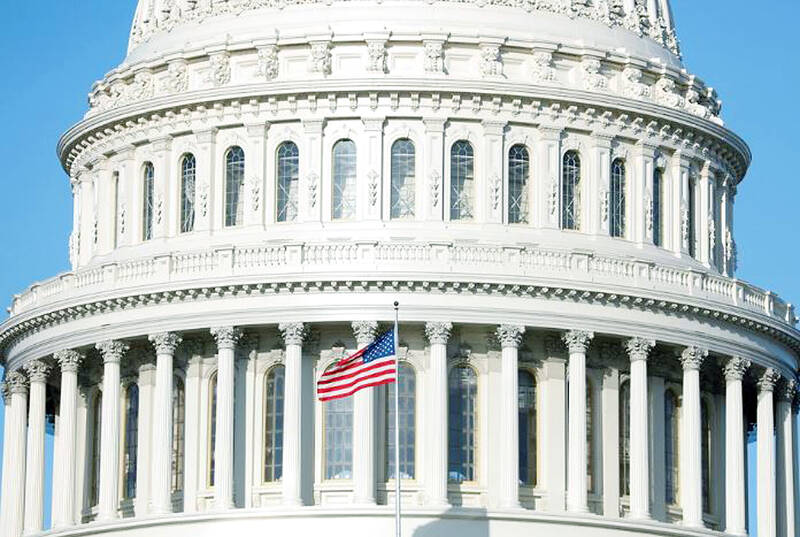The US Senate Committee on Armed Services on Friday passed a bill on the national defense policy and budget for the next fiscal year that includes provisions calling for military cooperation with Taiwan.
The US$886.3 billion budgeted under the National Defense Authorization Act (NDAA) was approved 24-1 by the committee, and has been sent to the Senate for approval.
An executive summary provided by the committee states that the US would seek to strengthen its posture in the Indo-Pacific region, in view of “long-term strategic competition with China and Russia.”

Photo: Reuters
Part of that effort includes the US establishing “a comprehensive training, advising, and institutional capacity-building program for the military forces of Taiwan,” the bill states.
It also calls for “engagement with appropriate officials of Taiwan for the purpose of expanding cooperation on military cybersecurity activities.”
The passage of the bill by the committee followed a similar pattern to corresponding legislation in the US House of Representatives, which was passed by the House Armed Services Committee 58-1 on Thursday.
According to the proposal, known as the “Chairman’s Mark,” put forth on June 12 by House Armed Services Committee Chairman Mike Rogers, the House version of the bill encourages joint military exercises between Taiwan and the US, as well as exchanges among officials on both sides.
The bill also urges the US government to support Taiwan in acquiring defense articles and services “through foreign military sales, direct commercial sales, and industrial cooperation” to help build up its asymmetric capabilities.
The bill awaits approval by the House.
Once the Senate and House approve their versions of the NDAA, they must negotiate a final bill that each body has to pass before it can be signed into law by the president.
In Taipei, Institute for National Defense and Security Research analyst Shu Hsiao-huang (舒孝煌) yesterday said that the US Congress is sending a clear signal to the White House that the US must broaden its defense cooperation with Taiwan, including joint exercises to improve interoperability.
The Pentagon has repeatedly underscored interoperability of command and control as a key capability that the US and allied forces must obtain in joint exercises, he said, adding that this would significantly augment the combat performance of a military coalition.
The US conducts joint exercises with South Korea, Japan, the Philippines and Indonesia, which comprise the entirety of the first island chain minus Taiwan, leaving a gap in capabilities, he said.
Current military exercises carried out by Taiwan and the US do not qualify as true joint exercises, he said.
Taiwan-US defense cooperation is conducted too sporadically and does not include senior commanders, which means the methods of waging modern war on a large scale and fresh ideas from the US cannot be learned, Shu said.

A magnitude 7.0 earthquake struck off Yilan at 11:05pm yesterday, the Central Weather Administration (CWA) said. The epicenter was located at sea, about 32.3km east of Yilan County Hall, at a depth of 72.8km, CWA data showed There were no immediate reports of damage. The intensity of the quake, which gauges the actual effect of a seismic event, measured 4 in Yilan County area on Taiwan’s seven-tier intensity scale, the data showed. It measured 4 in other parts of eastern, northern and central Taiwan as well as Tainan, and 3 in Kaohsiung and Pingtung County, and 2 in Lienchiang and Penghu counties and 1

A car bomb killed a senior Russian general in southern Moscow yesterday morning, the latest high-profile army figure to be blown up in a blast that came just hours after Russian and Ukrainian delegates held separate talks in Miami on a plan to end the war. Kyiv has not commented on the incident, but Russian investigators said they were probing whether the blast was “linked” to “Ukrainian special forces.” The attack was similar to other assassinations of generals and pro-war figures that have either been claimed, or are widely believed to have been orchestrated, by Ukraine. Russian Lieutenant General Fanil Sarvarov, 56, head

FOREIGN INTERFERENCE: Beijing would likely intensify public opinion warfare in next year’s local elections to prevent Lai from getting re-elected, the ‘Yomiuri Shimbun’ said Internal documents from a Chinese artificial intelligence (AI) company indicated that China has been using the technology to intervene in foreign elections, including propaganda targeting Taiwan’s local elections next year and presidential elections in 2028, a Japanese newspaper reported yesterday. The Institute of National Security of Vanderbilt University obtained nearly 400 pages of documents from GoLaxy, a company with ties to the Chinese government, and found evidence that it had apparently deployed sophisticated, AI-driven propaganda campaigns in Hong Kong and Taiwan to shape public opinion, the Yomiuri Shimbun reported. GoLaxy provides insights, situation analysis and public opinion-shaping technology by conducting network surveillance

‘POLITICAL GAME’: DPP lawmakers said the motion would not meet the legislative threshold needed, and accused the KMT and the TPP of trivializing the Constitution The Legislative Yuan yesterday approved a motion to initiate impeachment proceedings against President William Lai (賴清德), saying he had undermined Taiwan’s constitutional order and democracy. The motion was approved 61-50 by lawmakers from the main opposition Chinese Nationalist Party (KMT) and the smaller Taiwan People’s Party (TPP), who together hold a legislative majority. Under the motion, a roll call vote for impeachment would be held on May 19 next year, after various hearings are held and Lai is given the chance to defend himself. The move came after Lai on Monday last week did not promulgate an amendment passed by the legislature that